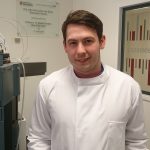2017 New Investigator Award: Liam Heaney
 Liam Heaney (University of Leicester, UK)
Liam Heaney (University of Leicester, UK)
What made you chose a career in bioanalysis?
I have always been fascinated with physiological responses to stimuli, be it imposed interventions (e.g. diet/exercise) or through natural progression (e.g. disease). Therefore, the measurement of physiologically relevant molecules is at the forefront of my interests. I began by investigating systemic inflammatory responses after extended exercise performances and expanded to the measurement of volatile and non-volatile metabolites in various biological sample mediums, including exhaled breath gases, saliva, plasma, serum and urine. Learning the technique of mass spectrometry has opened huge possibilities for my bioanalytical investigations and has been an important factor in shaping the decisions made regarding my career.
Describe the main highlights of your bioanalytical work?
Considering my origins in exercise science, developing the knowledge and understanding of chromatography and mass spectrometry is the foremost highlight of my bioanalytical journey. I applied exhaled breath gas analysis to perform novel metabolomics experiments in sporting situations, encompassing both environmental influences (e.g. exposure to chlorinated pool air), and physiological influences after maximal exercise. A major highlight of my PhD research was the development of an on-line and transportable exhaled breath system using a compact mass spectrometer to aid in collecting high-quality exhaled breath samples for non-laboratory-based exercise studies. It has been rewarding to see this work extended and translated into hospital clinics. Following my PhD, I have translated the work learned in exercise investigations to explore small molecules, using LC-MS-MRM, as putative biomarkers in disease prognosis and risk stratification. It has been extremely fulfilling to develop and apply translational bioanalytical techniques, to compliment the literature for understanding the promise of novel biomarkers in cardiovascular disease. The high level of interest that this work has generated by the academic, clinical and public domains has also been a leading highlight of my bioanalytical work, and places in context the importance of the work completed by myself and other bioanalytical researchers.
How has your work impacted your laboratory, the bioanalytical field and beyond?
During my PhD, I developed a real-time exhaled breath measurement technique using a compact mass spectrometer. This set-up is now being rolled out into hospital clinics as part of a large multi-center research project. Since progressing into a postdoctoral role, I have been influential in setting up a clinical metabolomics program in our facility and I have passed on my knowledge and experience to the next generation of masters and PhD students. I have performed and published the first investigations into the prognostic value of trimethylamine N-oxide in acute heart failure and acute myocardial infarction patients. Our manuscript in acute heart failure was well received by the bioanalytical, clinical and public communities. The manuscript reached an Altmetrics score of >300 for its impact in the press and on social media, and led to our group being invited to film for the BBC’s documentary ‘The Truth about Meat’.
Describe the most difficult challenge you have encountered in your scientific career and how you overcame it?
As an undergraduate and masters’ student with an interest in exercise physiology, the transition to a PhD in metabolomics, as an underpinning aspect of physiological function, seemed a logical route. With the naïve attitude of ‘measure some metabolites and see’, little did I realize at the time just how advanced and technical the field of analytical science is. The progression into the use of chromatography and mass spectrometry was extremely challenging and one that required a great amount of effort and enthusiasm to overcome. I was, and still am, extremely interested in how metabolic pathways are affected by physiological changes and this drove me to study the theory and applications of analytical chemistry and metabolomics. To help me overcome this challenge, I engaged in discussion with my peers, studied books and research literature, and attended multiple workshops available across the UK that are designed for scientists in my position. Although there have been analytical challenges both within the laboratory as well as when writing up my PhD thesis and publications, without the effort that was focused to learning these new techniques I would never have progressed and reached the research milestones of my career to date.
Describe your role in bioanalytical communities/groups?
I have been a member of the British Mass Spectrometry Society (BMSS) since 2011 and I have regularly attended their annual meeting, and in September 2016 I was invited to this event give an oral presentation about my work on trimethylamine N-oxide. This presentation led to an invitation to contribute an opinion piece to The Analytical Scientist Magazine for its February 2017 issue. Further to this I am a member of the BMSS’s Clinical and Forensic, Quantitative MS and Ambient Ionization special interest groups. Furthermore, although I am based in the Department of Cardiovascular Sciences, I have been active in collaborations across multiple disciplinary groups. These include biomarker investigations in cancer, diabetes and exercise physiology. In addition to this, I actively collaborate with industrial partners, and have recently been a contributing author to the publication of a manuscript in Proteomics with Waters Corporation. Aside from research, I am also an associate supervisor to three PhD students, passing on my experiences and knowledge, as well running seminars for masters’ students in bioanalytical and biostatistical processes.
List up to five of your publications in the field of bioanalysis:
1Heaney LM, Ruszkiewicz DM, Arthur KL, Hadjithekli A, Aldcroft C, Lindley MR, Thomas CP, Turner MA, Reynolds JC. Real-time monitoring of exhaled volatiles using atmospheric pressure chemical ionization on a compact mass spectrometer. Bioanalysis 2016;8:1325-36.
2Suzuki T*, Heaney LM*, Bhandari SS, Jones DJ, Ng LL. Trimethylamine N-oxide and prognosis in acute heart failure. Heart 2016;102:841-8.
3Suzuki T*, Heaney LM*, Jones DJ, Ng LL. Trimethylamine N-oxide and Risk Stratification after Acute Myocardial Infarction. Clinical Chemistry 2017;63:420-8.
4Heaney LM, Jones DJ, Mbasu RJ, Ng LL, Suzuki T. High mass accuracy assay for trimethylamine N-oxide using stable-isotope dilution with liquid chromatography coupled to orthogonal acceleration time of flight mass spectrometry with multiple reaction monitoring. Analytical and Bioanalytical Chemistry 2016;408:797-804.
5Mbasu RJ*, Heaney LM*, Molloy BJ*, Hughes CJ*, Ng LL, Vissers JP, Langridge JI, Jones DJ. Advances in quadrupole and time-of-flight mass spectrometry for peptide MRM based translational research analysis. Proteomics 2016;16:2206-20.
Find out more about this year’s New Investigator Award, the judging panel and the rest of our nominees.


